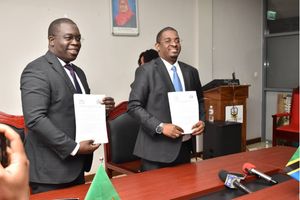Shareholders in spotlight over collapse of Bank M

Central bank deputy governor Bernard Kibesse addresses journalists during a press conference in Dar es Salaam yesterday. The Bank of Tanzania announced yesterday that Bank M would be merged with Azania Bank. PHOTO | ANTHONY SIAME
What you need to know:
- Clients, including shareholders of Bank M, received loans totaling to Sh618 billion which ultimately saw the once shinning financial entity going under.
- Bank M, which had operated profitably for nine of the 11 years of its existence in the country, abruptly faced a serious liquidity challenge last year (2018), prompting the Bank of Tanzania (BoT) to put it (Bank M’s) under its (the BoT’s) administration in August (August 2018).
Dar es Salaam. Clients, including shareholders of Bank M, received loans amounting to Sh618 billion, which ultimately saw the once shining financial entity collapsing.
Bank M, which had operated profitably for nine of the 11 years of its existence in the country, abruptly started facing serious liquidity challenges last year, prompting the Bank of Tanzania (BoT) to put it under its administration last August.
Signs that Bank M would go under started showing early last year whereby as of June 30, 2018, its total loans had surpassed the deposits by 32.7 per cent.
It held Sh422.7 billion in customers’ deposits as of June 30, 2018 compared to Sh628.4 billion that it had issued out in loans, advances and overdrafts, its financial statements showed.
As a result, Bank M ended up having more liabilities meaning it was required to pay out more than what it actually could collect from its debtors.
With the failure to honour its obligations through customer payments and withdrawals, some banks and customers started panicking.
And, speaking in Dar es Salaam yesterday, Bank M’s statutory manager Sadati Musa said the total loan reached a point where the lender could no longer sustain its operations.
“I think there was a technical error on how the loans were being handled to the extent of exhausting the lender’s liquidity,” said Mr Musa.
The central bank’s deputy governor for financial stability and deepening, Dr Benard Kibesse, issued a seven-day ultimatum, starting today, to an unspecified number of Bank M’s shareholders who took loans to report to the BoT and agree on repayment plans.
“They must come. If they believe that merging these banks [the BoT yesterday merged Bank M with Azania Bank] gives them a leeway to dodge repayment of their loans, then they should understand that that chance does not exist,” said Dr Kibesse.
The central bank put Bank M under its statutory management on August 2, 2018 but when the three months had expired, the banking sector regulator extended the period by two more months.
It was after the expiry of the extended two-month period that the regulator yesterday announced the decision to merge Bank M with Azania Bank.
Under the merger, he said all customers, employees, assets and liabilities for Bank M will be transferred to Azania Bank.
Dr Kibese allayed fears to customers of Bank M, saying their deposits would remain safe under the new arrangement.
The merger means that Azania Bank’s total assets will now jump to over Sh1 trillion while its capital will also rise to Sh164 billion.
As of the year ending December 2017, Azania Bank’s total assets stood at Sh388.983 billion while its paid up share capital was Sh59.669 billion, according to the bank’s financial statements.
The year 2018 will be remembered in the history of the banking sector in Tanzania for being the one when the BoT made tough decisions against banks.
Apart from Bank M, in January 2018, the BoT revoked the banking licences of Covenant Bank, Efatha Bank, Njombe Community Bank, Kagera Farmers’ Cooperative Bank, and Meru Community Bank, on the basis of their undercapitalisation.
The BoT said then that the decision came upon determination that the aforesaid banks were critically undercapitalised, hence violating the requirements of the Banking and Financial Institutions Act, 2006 and its regulation.
Bank M shareholders
Available data shows that Bank M is owned by 15 individuals/companies.
Vimal Mehta owns a 16.03 per cent stake while Equity & Allied Limited and Sean Patrick Breslin come in second and third positions respectively with 12.17 and 11.63 per cent shareholding respectively.
Other shareholders and their shareholding percentage in brackets include: Africarriers Limited (11) Sanjeev (10.53), Noble Azania Investment Limited (7.3), Khaskar Nair (7.09), Sumaria Properties Limited (4.87) and Simon & Roisin Gregory (4.45).
The list also include: Pride Tanzania Limited (3.46), Ramesh Patel (3.26), Gissings Directors Pension Scheme (2.47), Shiva Sanjeev Kumar (1.42) and Caitrin Breslin (0.90 per cent).
On the other hand, Azania Bank was established in 1995, as First Adili Bancorp.
So far, the bank is owned by the National Social Security Fund (NSSF) which has a 34.8 per cent stake. PPF, PSPF and LAFP own 30.1 per cent, 17.2 per cent and 14.2 per cent respectively. The three pension funds have since been merged with GEPF to form the Public Sector Social Security Fund (PSSSF).
The East Africa development Bank and other minority shareholders, including the bank’s staff own 2.3 per cent and 1.4 per cent respectively.




